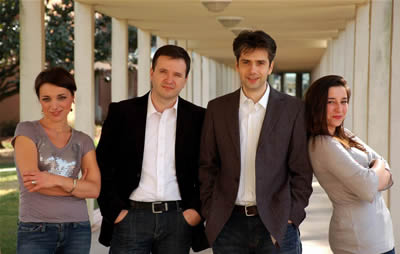My, oh my, the Red Priest must have loved those 16th notes! How else can you explain the abundance of them in so many of his works? Never mind whether they are in scores for stringed or wind instruments, Antonio Vivaldi must have thought that all soloists had the nimblest of fingers.
Christine Gustafson, the flute soloist in Vivaldi’s “Goldfinch” concerto, the highlight of the brief East Carolina University Chamber Orchestra concert at A.J. Fletcher Recital Hall, did indeed possess the nimble fingers and firm breath control required to negotiate the tricky outer movements of the composition. The concerto (in D, Op. 10, No. 3, known as “Il gardellino” or “Il cardellino”) opens with a bird call solo line that reminds one, if only faintly, of similar bird calls in Beethoven’s “Pastoral” symphony, as well as the cuckoo’s call in Vivaldi’s own “Summer” concerto from The Four Seasons.
Gustafson, associate professor of flute at ECU, engaged in a nice duet with first violinist Rebecca Gourley in the opening movement, and then she and cellist Stephen Duran played a beautiful duet that constituted the entire slow middle movement (no 16th notes here!). Then back to up-tempo scoring in the final allegro movement with what seemed like one fluttering tremolo after another. The concerto is only 10 minutes long, but the soloist and chamber ensemble packed a lot of notes into those 10 minutes. Under Jorge Richter’s direction, the orchestra acquitted itself nicely throughout.
The program opened with Benjamin Britten’s “Simple Symphony for String Orchestra” and closed with Haydn’s Symphony No. 49 in F minor (“La Passione”). The audience heard some good playing along with a few shaky moments as well.
Britten’s symphony, a lovely piece dating from the mid-1930s, has wonderfully named movements, perhaps befitting a piece composed for a school ensemble: “Boisterous Bouree,” “Playful Pizzicato,” “Sentimental Saraband” and “Frolicsome Finale.” After its emphatic opening and dance-like melody, the “Bouree” moves along to close with a fugue-like passage. The “Pizzicato” is lighter and much shorter than, say, Tchaikovsky’s famous Fourth Symphony pizzicato, but it is quite exhilarating nonetheless, and the players applied considerable energy to both the plucked and strummed attacks. The “Saraband,” the longest of the four movements, imparts a feeling of melancholy, of wistfulness, even sadness, and the young players infused the reading with considerable emotion and a good blend of sound in all parts. The “Finale,” a prestissimo con fuoco, returned to high-energy playing with a forceful opening not unlike the first part of the first movement, along with some tension and drama, and a bit of pizzicato interspersed with ominous rumblings in the cellos and bass.
Haydn’s Symphony No. 49 opens dramatically, not with a fast-tempoed allegro, but with a slow and somber adagio, and then it moves into more liveliness. The adagio is quite emotional, and the musicians did not play as well on this piece as they did on Britten’s “Saraband.” The movement suffered mainly from imprecise pitches, but as the playing accelerated, the pitches improved, and timing and attacks were good throughout. The third movement, a menuet, seemed a bit heavy at times, and the ascending horn passages were a bit shaky, but the final presto movement, with its abrupt finish, was quite lively, perhaps the best tone and playing of the entire work.












